trailer MITSUBISHI L200 2015 Owner's Manual (in English)
[x] Cancel search | Manufacturer: MITSUBISHI, Model Year: 2015, Model line: L200, Model: MITSUBISHI L200 2015Pages: 418, PDF Size: 25.8 MB
Page 133 of 418

Economical driving............................................................................. 6-02
Driving, alcohol and drugs.................................................................. 6-02
Safe driving techniques....................................................................... 6-03
Running-in recommendations............................................................. 6-04 Parking brake...................................................................................... 6-07
Parking................................................................................................ 6-08
Steering wheel height adjustment....................................................... 6-09
Inside rear-view mirror....................................................................... 6-09 Outside rear-view mirrors................................................................... 6-10
Ignition switch.....................................................................................6-12 Steering wheel lock............................................................................. 6-13
Starting................................................................................................ 6-13 Diesel particulate filter (DPF)*........................................................... 6-15Manual transmission........................................................................... 6-16Automatic transmission Sports Mode 4A/T, 5A/T............................. 6-19Easy select 4WD*............................................................................... 6-25
Super select 4WD*..............................................................................6-29
Rear differential lock*........................................................................ 6-34 4-wheel drive operation...................................................................... 6-38
Inspection and maintenance following rough road operation............. 6-41
Cautions on handling of 4-wheel drive vehicles................................. 6-41
Limited-slip differential*.................................................................... 6-43
Braking................................................................................................ 6-43
Brake assist system*........................................................................... 6-44
Anti-lock brake system (ABS)*.......................................................... 6-45
Power steering system.........................................................................6-48 Active Stability & Traction Control (ASTC)*....................................6-48
Cruise control*.................................................................................... 6-50 Cargo loads......................................................................................... 6-55Trailer towing......................................................................................6-55Starting and driving
OKTE15E36
Page 136 of 418
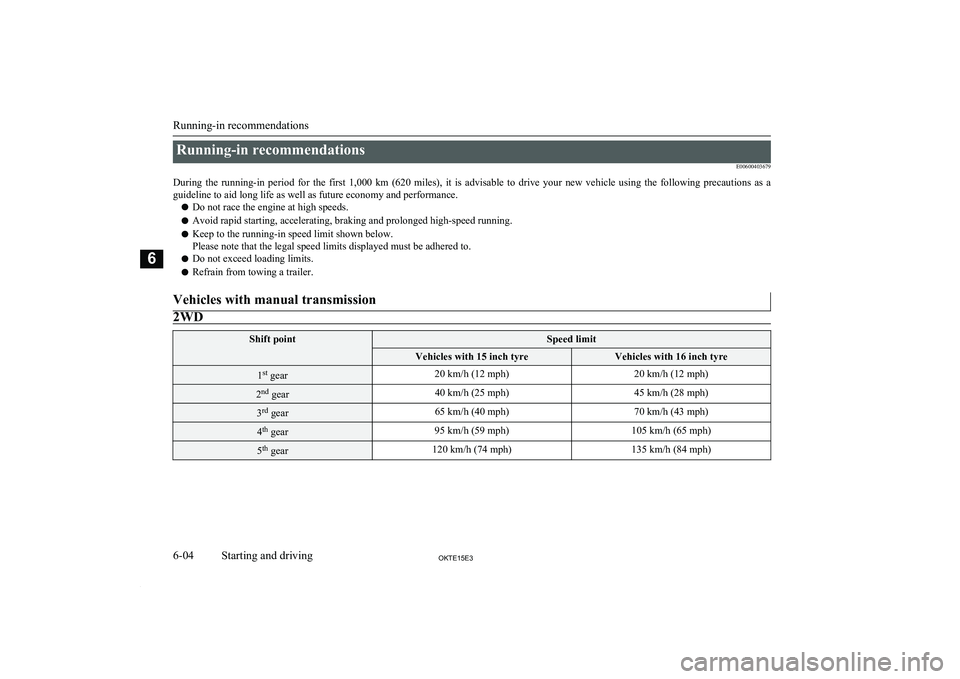
Running-in recommendationsE00600403679
During the running-in period for the first 1,000 km (620 miles), it is advisable to drive your new vehicle using the following precautions as a guideline to aid long life as well as future economy and performance.
l Do not race the engine at high speeds.
l Avoid rapid starting, accelerating, braking and prolonged high-speed running.
l Keep to the running-in speed limit shown below.
Please note that the legal speed limits displayed must be adhered to.
l Do not exceed loading limits.
l Refrain from towing a trailer.Vehicles with manual transmission2WDShift pointSpeed limitVehicles with 15 inch tyreVehicles with 16 inch tyre1st
gear20 km/h (12 mph)20 km/h (12 mph)2nd
gear40 km/h (25 mph)45 km/h (28 mph)3rd
gear65 km/h (40 mph)70 km/h (43 mph)4th
gear95 km/h (59 mph)105 km/h (65 mph)5th
gear120 km/h (74 mph)135 km/h (84 mph)
Running-in recommendations
6-04OKTE15E3Starting and driving6
Page 187 of 418
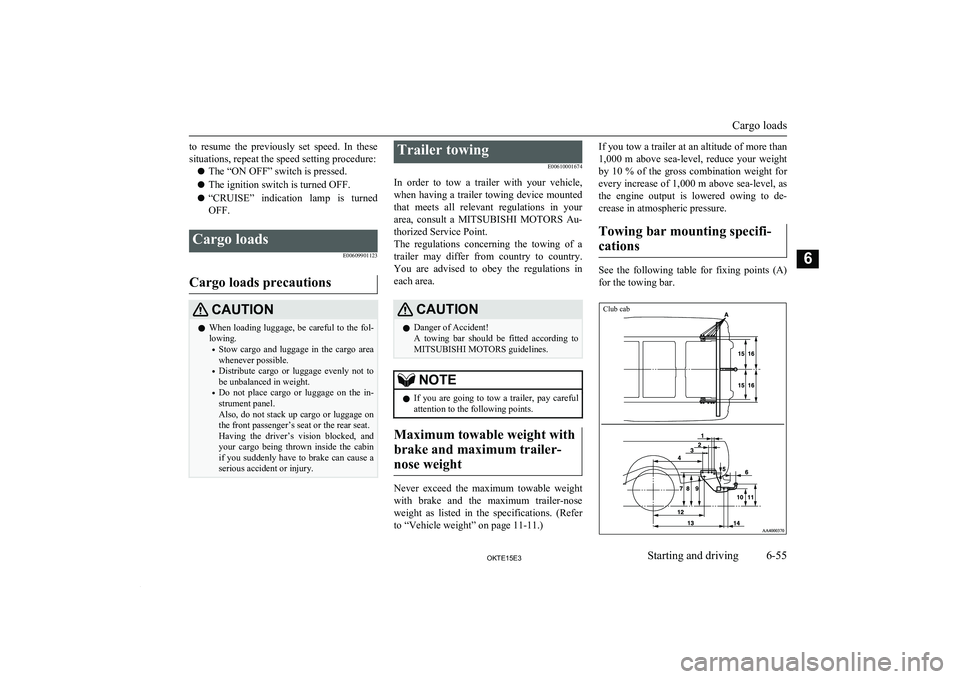
to resume the previously set speed. In thesesituations, repeat the speed setting procedure:
l The “ON OFF” switch is pressed.
l The ignition switch is turned OFF.
l “CRUISE” indication lamp is turned
OFF.Cargo loads
E00609901123
Cargo loads precautions
CAUTIONlWhen loading luggage, be careful to the fol-
lowing.
• Stow cargo and luggage in the cargo area
whenever possible.
• Distribute cargo or luggage evenly not to
be unbalanced in weight.
• Do not place cargo or luggage on the in-
strument panel.
Also, do not stack up cargo or luggage on the front passenger’s seat or the rear seat.
Having the driver’s vision blocked, and
your cargo being thrown inside the cabin if you suddenly have to brake can cause a
serious accident or injury.Trailer towing
E00610001674
In order to tow a trailer with your vehicle,
when having a trailer towing device mounted that meets all relevant regulations in your
area, consult a MITSUBISHI MOTORS Au-
thorized Service Point.
The regulations concerning the towing of a
trailer may differ from country to country. You are advised to obey the regulations in
each area.CAUTIONl Danger of Accident!
A towing bar should be fitted according to MITSUBISHI MOTORS guidelines.NOTEl If you are going to tow a trailer, pay careful
attention to the following points.
Maximum towable weight with
brake and maximum trailer- nose weight
Never exceed the maximum towable weight
with brake and the maximum trailer-nose weight as listed in the specifications. (Referto “Vehicle weight” on page 11-11.)
If you tow a trailer at an altitude of more than
1,000 m above sea-level, reduce your weight
by 10 % of the gross combination weight for
every increase of 1,000 m above sea-level, as the engine output is lowered owing to de-
crease in atmospheric pressure.
Towing bar mounting specifi-cations
See the following table for fixing points (A) for the towing bar.
Club cab
Cargo loads
6-55OKTE15E3Starting and driving6
Page 188 of 418

Single cab, Double cab
Trailer towing
6-56OKTE15E3Starting and driving6
Page 189 of 418
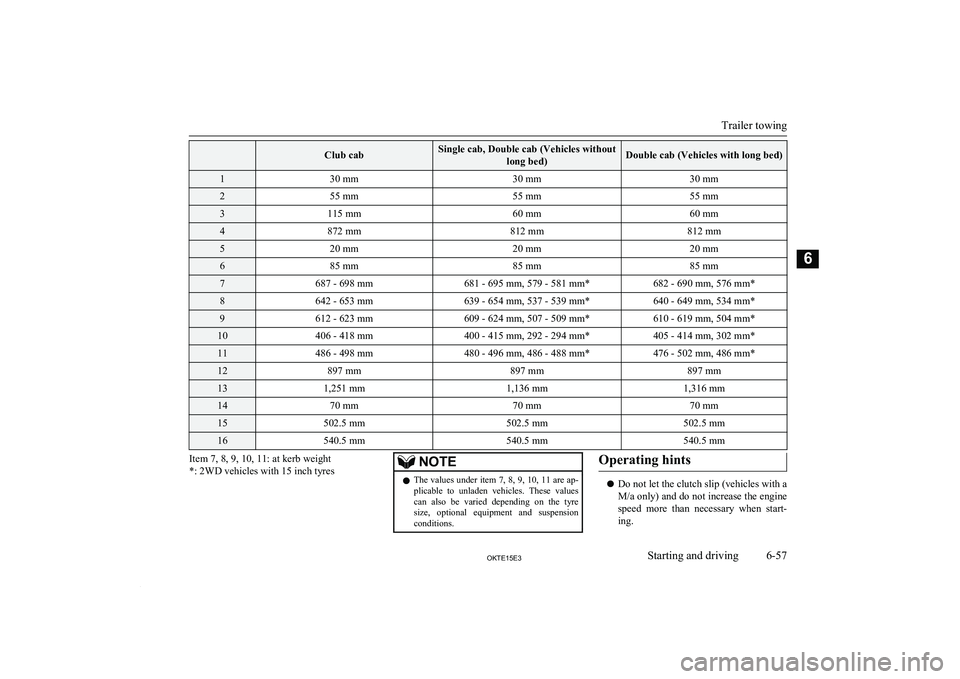
Club cabSingle cab, Double cab (Vehicles withoutlong bed)Double cab (Vehicles with long bed)130 mm30 mm30 mm255 mm55 mm55 mm3115 mm60 mm60 mm4872 mm812 mm812 mm520 mm20 mm20 mm685 mm85 mm85 mm7687 - 698 mm681 - 695 mm, 579 - 581 mm*682 - 690 mm, 576 mm*8642 - 653 mm639 - 654 mm, 537 - 539 mm*640 - 649 mm, 534 mm*9612 - 623 mm609 - 624 mm, 507 - 509 mm*610 - 619 mm, 504 mm*10406 - 418 mm400 - 415 mm, 292 - 294 mm*405 - 414 mm, 302 mm*11486 - 498 mm480 - 496 mm, 486 - 488 mm*476 - 502 mm, 486 mm*12897 mm897 mm897 mm131,251 mm1,136 mm1,316 mm1470 mm70 mm70 mm15502.5 mm502.5 mm502.5 mm16540.5 mm540.5 mm540.5 mmItem 7, 8, 9, 10, 11: at kerb weight
*: 2WD vehicles with 15 inch tyresNOTEl The values under item 7, 8, 9, 10, 11 are ap-
plicable to unladen vehicles. These values
can also be varied depending on the tyre size, optional equipment and suspension
conditions.Operating hints
l Do not let the clutch slip (vehicles with a
M/a only) and do not increase the engine
speed more than necessary when start-
ing.Trailer towing
6-57OKTE15E3Starting and driving6
Page 190 of 418
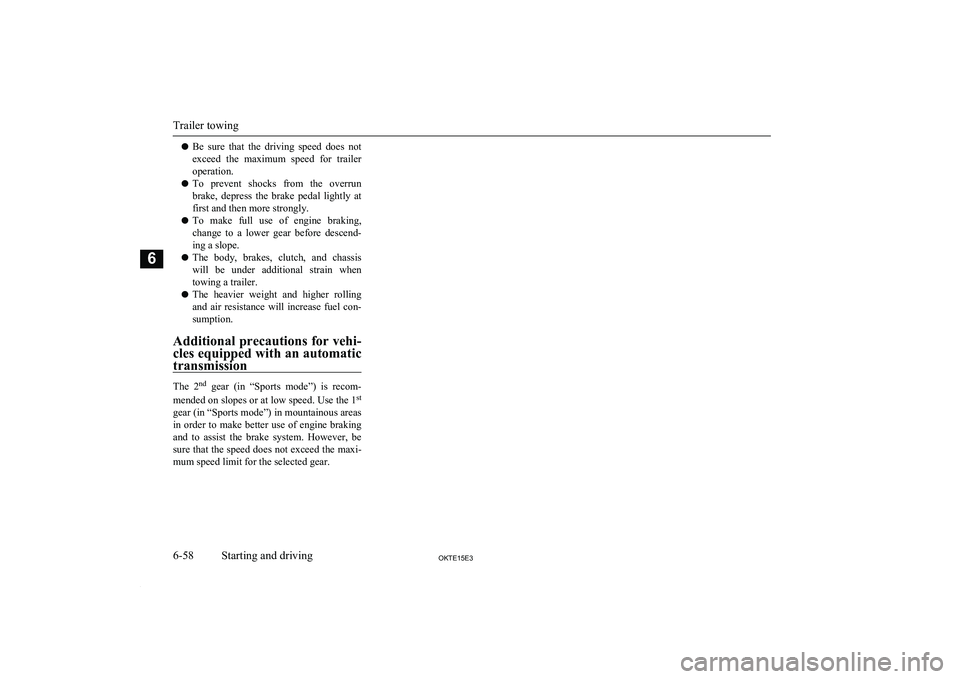
lBe sure that the driving speed does not
exceed the maximum speed for trailer
operation.
l To prevent shocks from the overrun
brake, depress the brake pedal lightly at first and then more strongly.
l To make full use of engine braking,
change to a lower gear before descend-
ing a slope.
l The body, brakes, clutch, and chassis
will be under additional strain when
towing a trailer.
l The heavier weight and higher rolling
and air resistance will increase fuel con- sumption.
Additional precautions for vehi-
cles equipped with an automatic
transmission
The 2 nd
gear (in “Sports mode”) is recom-
mended on slopes or at low speed. Use the 1 st
gear (in “Sports mode”) in mountainous areas
in order to make better use of engine braking and to assist the brake system. However, be
sure that the speed does not exceed the maxi- mum speed limit for the selected gear.
Trailer towing
6-58OKTE15E3Starting and driving6
Page 354 of 418
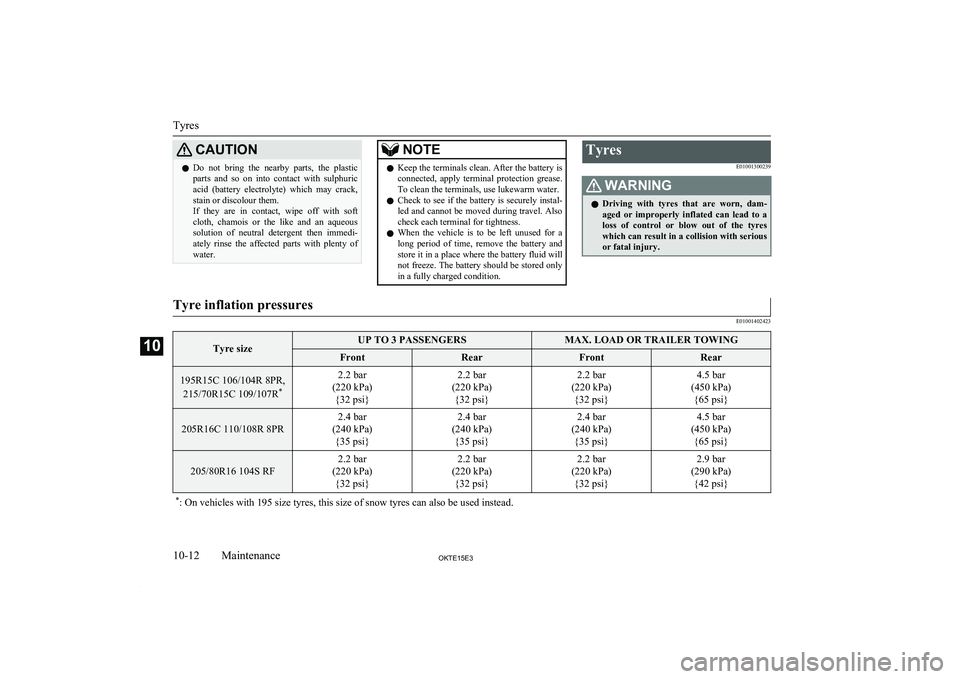
CAUTIONlDo not bring the nearby parts, the plastic
parts and so on into contact with sulphuric acid (battery electrolyte) which may crack,
stain or discolour them.
If they are in contact, wipe off with soft cloth, chamois or the like and an aqueous
solution of neutral detergent then immedi-
ately rinse the affected parts with plenty of water.NOTEl Keep the terminals clean. After the battery is
connected, apply terminal protection grease.
To clean the terminals, use lukewarm water.
l Check to see if the battery is securely instal-
led and cannot be moved during travel. Also check each terminal for tightness.
l When the vehicle is to be left unused for a
long period of time, remove the battery and
store it in a place where the battery fluid will not freeze. The battery should be stored only in a fully charged condition.Tyres
E01001300239WARNINGlDriving with tyres that are worn, dam-
aged or improperly inflated can lead to a
loss of control or blow out of the tyres which can result in a collision with serious
or fatal injury.Tyre inflation pressures
E01001402423Tyre sizeUP TO 3 PASSENGERSMAX. LOAD OR TRAILER TOWINGFrontRearFrontRear195R15C 106/104R 8PR,
215/70R15C 109/107R *2.2 bar
(220 kPa) {32 psi}2.2 bar
(220 kPa) {32 psi}2.2 bar
(220 kPa) {32 psi}4.5 bar
(450 kPa) {65 psi}
205R16C 110/108R 8PR
2.4 bar
(240 kPa) {35 psi}2.4 bar
(240 kPa) {35 psi}2.4 bar
(240 kPa) {35 psi}4.5 bar
(450 kPa) {65 psi}
205/80R16 104S RF
2.2 bar
(220 kPa) {32 psi}2.2 bar
(220 kPa) {32 psi}2.2 bar
(220 kPa) {32 psi}2.9 bar
(290 kPa) {42 psi}* : On vehicles with 195 size tyres, this size of snow tyres can also be used instead.
Tyres
10-12OKTE15E3Maintenance10
Page 355 of 418
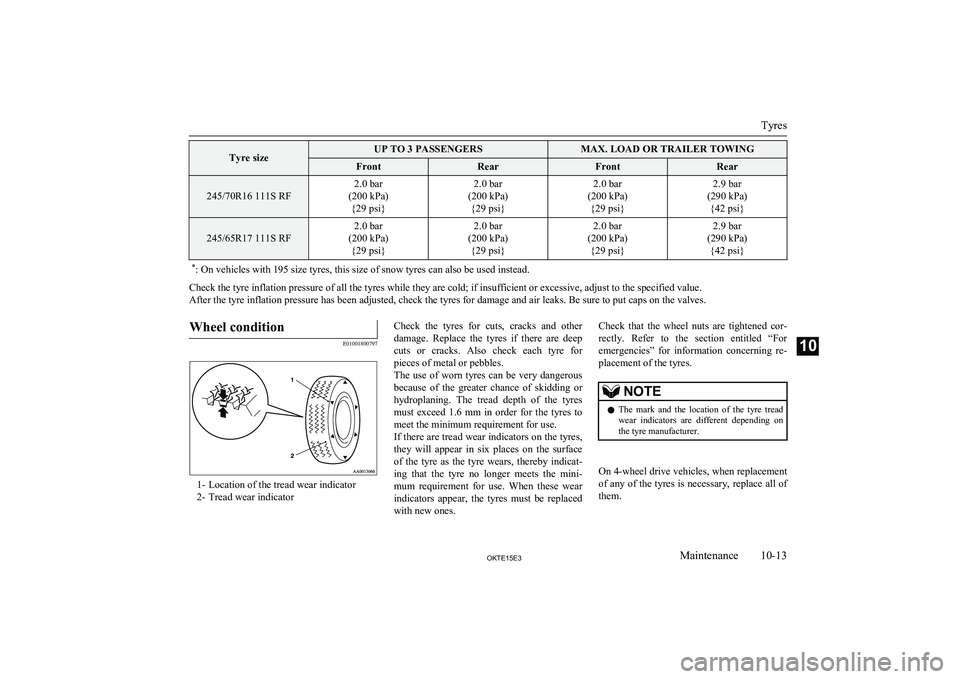
Tyre sizeUP TO 3 PASSENGERSMAX. LOAD OR TRAILER TOWINGFrontRearFrontRear
245/70R16 111S RF
2.0 bar
(200 kPa) {29 psi}2.0 bar
(200 kPa) {29 psi}2.0 bar
(200 kPa) {29 psi}2.9 bar
(290 kPa) {42 psi}
245/65R17 111S RF
2.0 bar
(200 kPa) {29 psi}2.0 bar
(200 kPa) {29 psi}2.0 bar
(200 kPa) {29 psi}2.9 bar
(290 kPa) {42 psi}* : On vehicles with 195 size tyres, this size of snow tyres can also be used instead.
Check the tyre inflation pressure of all the tyres while they are cold; if insufficient or excessive, adjust to the specified value.
After the tyre inflation pressure has been adjusted, check the tyres for damage and air leaks. Be sure to put caps on the valves.
Wheel condition
E01001800797
1- Location of the tread wear indicator
2- Tread wear indicator
Check the tyres for cuts, cracks and other
damage. Replace the tyres if there are deep
cuts or cracks. Also check each tyre for pieces of metal or pebbles.
The use of worn tyres can be very dangerous
because of the greater chance of skidding or
hydroplaning. The tread depth of the tyres
must exceed 1.6 mm in order for the tyres to meet the minimum requirement for use.
If there are tread wear indicators on the tyres,
they will appear in six places on the surface of the tyre as the tyre wears, thereby indicat- ing that the tyre no longer meets the mini-
mum requirement for use. When these wear
indicators appear, the tyres must be replaced
with new ones.Check that the wheel nuts are tightened cor-
rectly. Refer to the section entitled “For emergencies” for information concerning re-
placement of the tyres.NOTEl The mark and the location of the tyre tread
wear indicators are different depending on
the tyre manufacturer.
On 4-wheel drive vehicles, when replacement of any of the tyres is necessary, replace all of
them.
Tyres
10-13OKTE15E3Maintenance10
Page 391 of 418
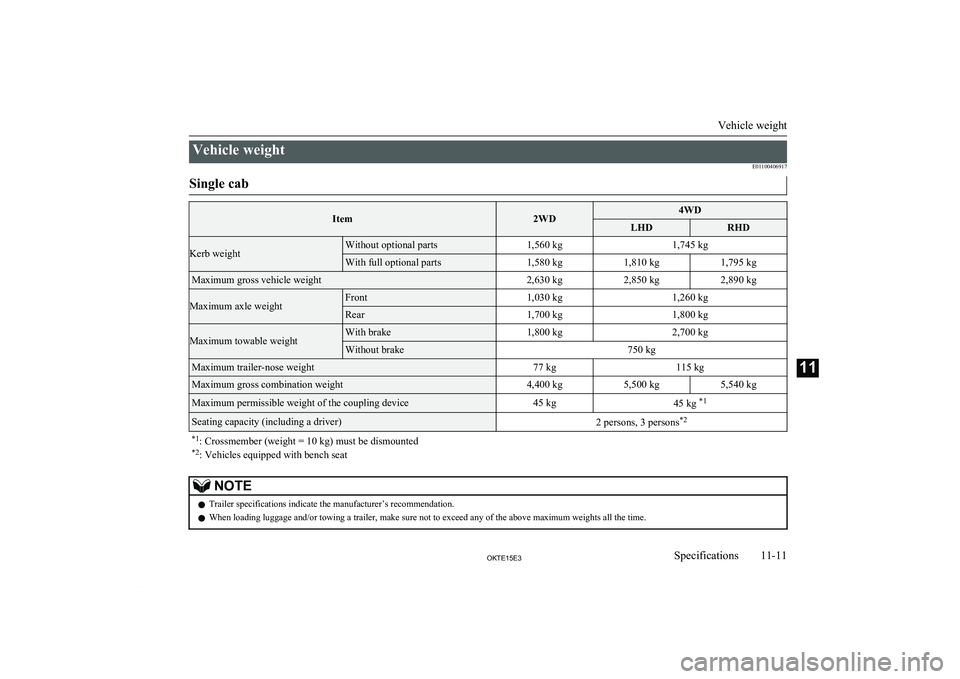
Vehicle weightE01100406917Single cabItem2WD4WDLHDRHDKerb weightWithout optional parts1,560 kg1,745 kgWith full optional parts1,580 kg1,810 kg1,795 kgMaximum gross vehicle weight2,630 kg2,850 kg2,890 kgMaximum axle weightFront1,030 kg1,260 kgRear1,700 kg1,800 kgMaximum towable weightWith brake1,800 kg2,700 kgWithout brake750 kgMaximum trailer-nose weight77 kg115 kgMaximum gross combination weight4,400 kg5,500 kg5,540 kgMaximum permissible weight of the coupling device45 kg45 kg *1Seating capacity (including a driver)2 persons, 3 persons *2*1
: Crossmember (weight = 10 kg) must be dismounted
*2 : Vehicles equipped with bench seatNOTEl Trailer specifications indicate the manufacturer’s recommendation.
l When loading luggage and/or towing a trailer, make sure not to exceed any of the above maximum weights all the time.
Vehicle weight
11-11OKTE15E3Specifications11
Page 392 of 418
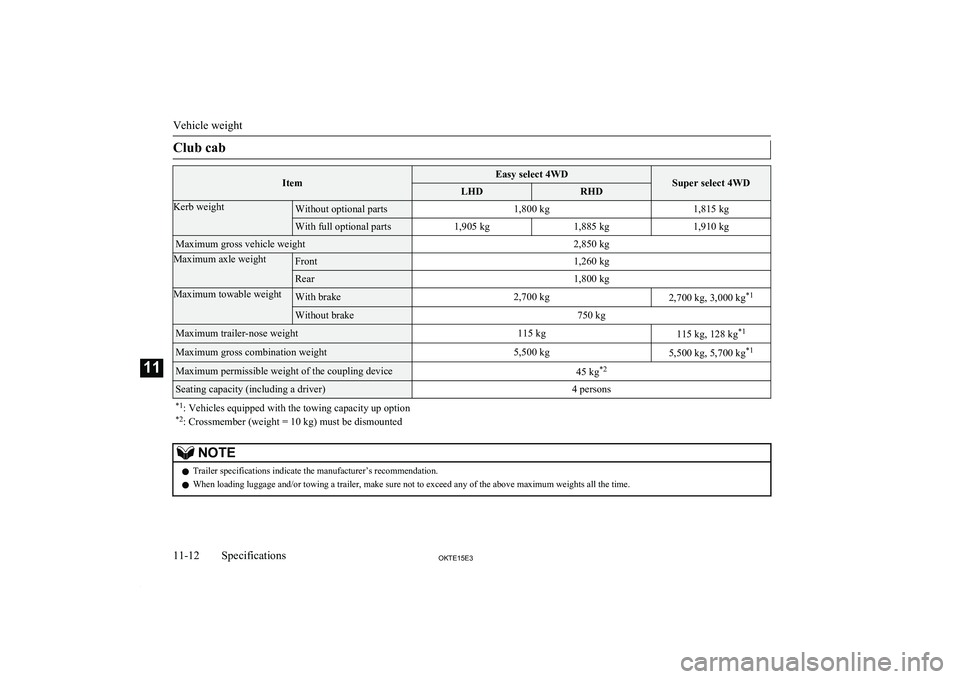
Club cabItemEasy select 4WDSuper select 4WDLHDRHDKerb weightWithout optional parts1,800 kg1,815 kgWith full optional parts1,905 kg1,885 kg1,910 kgMaximum gross vehicle weight2,850 kgMaximum axle weightFront1,260 kgRear1,800 kgMaximum towable weightWith brake2,700 kg2,700 kg, 3,000 kg*1Without brake750 kgMaximum trailer-nose weight115 kg115 kg, 128 kg*1Maximum gross combination weight5,500 kg5,500 kg, 5,700 kg *1Maximum permissible weight of the coupling device45 kg*2Seating capacity (including a driver)4 persons*1
: Vehicles equipped with the towing capacity up option
*2 : Crossmember (weight = 10 kg) must be dismountedNOTEl Trailer specifications indicate the manufacturer’s recommendation.
l When loading luggage and/or towing a trailer, make sure not to exceed any of the above maximum weights all the time.
Vehicle weight
11-12OKTE15E3Specifications11